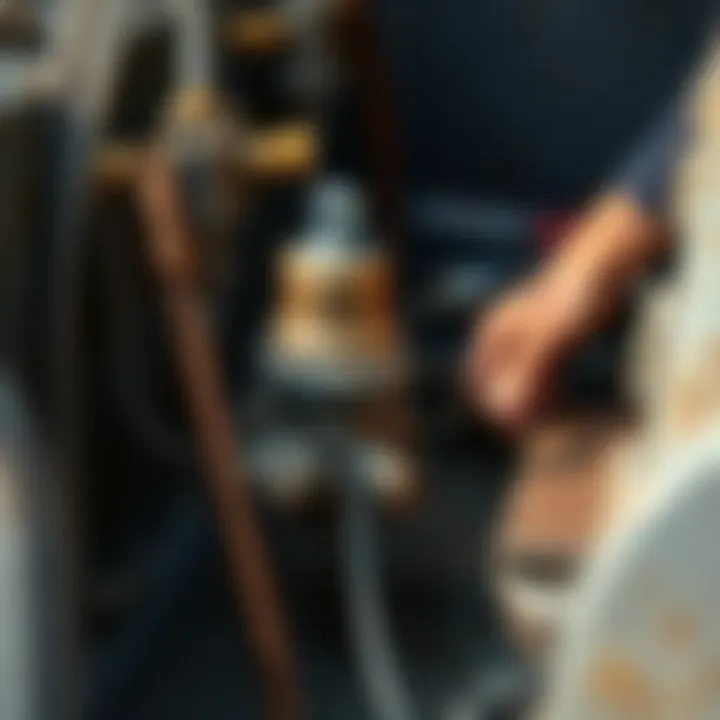Understanding Water Trough Float Valves: Their Purpose and Use


Intro
Water management is a cornerstone of successful agricultural practices. Among the many tools at a farmer's disposal, the water trough float valve stands out as an unsung hero. By controlling the water level in troughs meant for livestock and irrigation, these devices ensure a steady supply of water without wasting a single drop. In this article, we will explore the functionality and various applications of float valves, shedding light on their critical role in maintaining efficiency and sustainability on the farm.
Blogging just about the existence of these float valves doesn't quite cut it. It’s essential to unpack the intimate workings of how they function, why they matter in the grand scheme of agriculture, and what options are available for those keen on optimizing their water systems. Whether you're an experienced farmer or someone dabbling in agriculture, understanding the nuances of float valves can make a world of difference in your water management strategies.
Prelims to Water Trough Float Valves
Water trough float valves may not be the first topic that comes to mind when speaking about agricultural innovation, yet they perform a crucial role in ensuring a sustainable and efficient water supply for livestock and other applications. As farms increasingly seek to optimize their operations, understanding how these devices function can lead to better management practices and substantial savings.
Definition and Role
Float valves are devices designed to automatically regulate the levels of water in troughs. They work by utilizing a buoyant float, which rises and falls with the water level, thereby controlling the opening and closing of the valve. When the water reaches a certain low point, the float drops, opening the valve to allow water to flow in. Conversely, when the water level is sufficiently high, the float rises, shutting off the supply. This process is vital for preventing overflow and ensuring that water is available when animals need it while conserving valuable resources.
These valves are commonly utilized in various settings beyond livestock watering, including irrigation systems designed for crop management and aquaculture. By understanding the operational mechanics of these devices, farmers can make informed choices that contribute to both animal welfare and sustainable agricultural practices.
Historical Context
The transition to automated water management started many decades ago, driven by the need for efficiency in agriculture. Historically, farmers relied on manual methods to check water levels and fill troughs. This was a time-consuming process that often led to either overfilling or dry troughs, both of which posed challenges to livestock health and crop yield.
The first float valves appeared in Europe during the early 19th century, primarily serving industrial applications. As interest in productivity grew during the industrial revolution, innovations in farming technology soon included these valves. They proved indispensable in agricultural settings, allowing farmers to focus on other essential tasks while ensuring their animals always had adequate water without constant oversight.
Today, float valves have evolved with technological advancements, featuring various types and designs suited for diverse needs. Understanding their history highlights their significance and the impact they’ve had on modern farming methodologies. This article will cover the intricacies of float valves, their functional mechanics, and their applications, providing insights essential for both seasoned farmers and agricultural novices.
Mechanics of Float Valves
Understanding the mechanics of float valves is pivotal for appreciating their role in efficient water management. These devices ensure that water levels in troughs are regulated properly, providing a reliable source for agricultural needs. A clear comprehension of how they operate helps farmers make informed decisions about which type of valve suits their specific use cases. Efficiency, reliability, and sustainability all hinge on grasping these mechanics.
How Float Valves Operate
Float valves operate on a remarkably straightforward yet effective principle: a float attached to a lever. As water levels fluctuate, the float rises and falls accordingly, controlling the opening and closing of the valve. When water decreases, the float drops, which in turn opens the valve to refill the trough. Conversely, when the water reaches the desired level, the float lifts to shut the valve, preventing overflow. This seamless operation minimizes human intervention, ensuring a constant supply of water.
One might say, this system runs like a well-oiled machine—quite literally, as consistent performance hinges on its mechanical design.
Component Breakdown
A float valve is generally composed of three essential components that work in unison. Each one contributes significantly to the overall functionality of the valve.
Float Mechanism
The float mechanism is the heart of the float valve. It is typically made of materials like plastic or stainless steel, designed to resist buoyancy loss over time. One standout feature of this mechanism is its adaptability; it can be tailored in size and shape to fit various tank or trough designs. This versatility makes float mechanisms a popular choice for different applications in agriculture, from livestock watering systems to irrigation setups.
The primary advantage lies in its simple construction, which reduces the chances of mechanical failure. However, one must keep in mind that extreme temperatures or harsh chemicals can cause wear, influencing its long-term performance.
Valve Structure
The valve structure consists of various components such as bodies, seals, and sleeves. Its main job is to manage water flow effectively. A key characteristic of this structure is the reliability of the sealing mechanism, which prevents leakages—an undesirable event that can waste precious water and resources.
Typically crafted from durable materials like brass or plastic, valve structures cater to diverse environments. Their strong resistance to corrosion ensures long-lasting service. While older designs may require more frequent maintenance, newer models have incorporated features that minimize upkeep tasks.
Connection Types
The connection types utilized in float valves can range from threaded to slip fittings. Understanding these types is crucial; they dictate how the float valve integrates with the overall water system.
A standout feature is that the right connection can significantly reduce the likelihood of leaks, which can lead to costly water loss. For most agricultural setups, threaded connections are favored for their robustness, providing a secure fit and ensuring longevity.
However, while some prefer slip connections for easy installation, they may not offer the same level of durability. It’s essential to consider the specific characteristics of each connection type when determining which is most suitable for a given application.
Understanding the mechanics of float valves not only simplifies installation and maintenance but also optimizes water usage in agricultural practices, safeguarding resources and enhancing productivity.
Types of Float Valves
When it comes to managing water levels effectively, understanding the various types of float valves is crucial. Each type serves a unique purpose and offers distinct advantages depending on the application. Knowing these differences helps in selecting the right float valve for specific agricultural needs and ensures more sustainable water management practices.
Ball Float Valves
Ball float valves are perhaps the most commonly found type in agricultural settings. They feature a hollow ball, often made of plastic or metal, which floats on the surface of the water. As water levels rise, the ball lifts, eventually shutting off the water flow once it reaches a predetermined level.
Benefits of ball float valves include:
- Simplicity of design: Their straightforward mechanism means they are easy to install and maintain, making them accessible for many farmers.
- Reliability: When properly installed, they can function effectively over long periods without frequent adjustments.
- Durability: With materials suited for various conditions, they can withstand different climates and environments, helping to ensure the longevity of water troughs.
These valves play a crucial role in livestock water systems, keeping troughs filled while preventing overflow - a key aspect for maintaining farm hygiene.


Diaphragm Float Valves
Diaphragm float valves operate on a different principle. They utilize a flexible diaphragm that responds to water pressure. When the water level rises, it pushes against the diaphragm, which in turn closes the valve.
Some important points about these valves are:
- Precise water control: They allow for finer adjustments, making them ideal for applications where water levels need to be strictly regulated.
- Resistant to debris: The design minimizes the risk of clogging, which is particularly beneficial in agricultural environments where sediment or debris is common.
- Versatile installation: Diaphragm float valves can be fitted in various locations and orientations, offering flexibility for different farming setups.
Their adaptability and precision make them favorable for irrigation management, ensuring crops receive the right amount of water.
Paddle Float Valves
Paddle float valves use a paddle attached to a buoyant float, operating similarly to ball float valves but with a more engaging mechanism. As the water level rises, the paddle pivots to control the water flow.
Key benefits of paddle float valves include:
- Ideal for high-flow environments: These valves can handle larger volumes of water, making them well-suited for substantial agricultural applications.
- Streamlined operation: The simplicity of the paddle design allows for minimal maintenance, which can ease the workload during the busy farming season.
- Cost-effective solution: Often less expensive than other float valves, they offer a budget-friendly option for farmers looking to manage larger water bodies.
These valves see use in both livestock watering systems and irrigation systems, proving versatile across applications.
Customized Float Solutions
When the above standard float valves don’t meet specific requirements, customized float solutions come into play. Manufacturers often design tailor-made options based on farmer specifications or unique operational circumstances.
Considerations for customized float valves involve:
- Specialized materials: Depending on the local water quality and environmental conditions, a tailored valve can be created from more resistant materials to ensure longevity and performance.
- Design adaptations: Custom solutions can integrate multiple features, such as heightened sensitivity for water levels or additional controls for remote monitoring.
- Meeting specific needs: Whether for irregularly shaped troughs or unique water sources, customized valves enable farers to address specific challenges without compromising efficiency.
Customized float solutions empower farmers to optimize their water management strategy, making them a valuable consideration in modern agricultural practices.
Applications in Agriculture and Beyond
Water trough float valves serve as unsung heroes in the realm of agriculture, particularly in systems that rely heavily on water management. With their ability to自动调节水位,they are crucial to maintaining healthy livestock and efficient crop irrigation. This section sheds light on how these float valves are implemented across different applications in agriculture and other sectors, highlighting the benefits and considerations that come with their use.
Livestock Water Systems
The first point of call for float valves starts with livestock water systems. Ensuring a constant supply of fresh water for animals is paramount for their health and productivity. Float valves regulate water levels in troughs, which means that as animals drink, the water supply is automatically replenished. This minimizes the need for constant monitoring.
Key benefits include:
- Reduced Labor: Farmers can focus on other tasks while the system take care of itself.
- Healthier Livestock: Consistent access to fresh water means better animal welfare and improved growth rates.
- Cost-Effective: Less wastage of water and fewer manual checks lead to savings on overall operational costs.
However, it's not all smooth sailing. Farmers should bear in mind that regular inspection and maintenance are necessary to prevent malfunctions. In regions with heavy sediment or mineral deposits, float valves may need more frequent cleaning to ensure optimal performance.
Irrigation Management
In the context of irrigation, float valves play an essential role in efficient water management. They are implemented in various irrigation systems, from drip to flood irrigation, ensuring that fields receive just the right amount of water. An efficient water management system can significantly reduce water runoff and evaporation losses, which are common issues in agricultural settings.
Benefits of using float valves for irrigation include:
- Water Conservation: Using these valves allows farmers to implement sustainable practices that conserve resources.
- Dynamic Control: Float valves can adapt to varying water needs based on weather conditions, soil moisture levels, and crop requirements.
- Simplicity in Operation: Once installed, the focus shifts from operation to monitoring, making it easier for farmers to manage their land.
Practicality, however, does not come without challenges. Ensuring proper installation is crucial, as poorly set up float valves can lead to over-irrigation, resulting in waterlogging and nutrient leaching from soils.
Aquaculture Practices
Float valves also find applications in aquaculture, where maintaining correct water levels is vital for fish health. In aquaculture systems, water quality directly impacts growth and species survival rates. Float valves help to automate water exchanges and manage levels, creating a more stable environment for aquatic life.
Important aspects to consider are:
- Stability of Environment: Consistent water levels lead to stable temperatures and reduce stress on fish.
- Integration with Filtration Systems: Float valves can be linked to filtration units, ensuring clean water continuously circulates through the aquatic ecosystem.
- Risk Mitigation: Frequent checks can be reduced, thereby decreasing the risk of human error in manual systems.
Yet, aquaculturists must ensure that the float valves are compatible with their specific tanks and species. Maintaining appropriate water temperature and quality requires careful monitoring, even with automated systems.
"In agriculture, as in life, the simplest solutions often yield the biggest results. Float valves are a prime example."
Overall, applications of water trough float valves in livestock, irrigation, and aquaculture underscore their necessity within the broader context of agriculture and resource management. Understanding the fundamental roles these valves play can lead to more sustainable and efficient practices, enhancing agricultural productivity while conserving precious water resources.
Installation Guidelines
Proper installation of water trough float valves is paramount to ensuring their effectiveness and longevity. Deviating from the right procedures can lead to a host of issues that not only compromise performance but may also cause unnecessary waste of water and time. An informed approach to installation can streamline water management in agricultural settings and enhance overall efficiency.
Preparation Steps


Before diving into installing the valve, there are certain groundwork steps that must be taken. Start by gathering all necessary tools and materials: this includes the float valve itself, connecting pipes, fittings, wrenches, and a level gauge. Not having these items at hand can turn what should be a straightforward process into an unnecessarily drawn-out ordeal.
Next, assess the location where the valve will be installed. Select a site that allows for easy access for future maintenance and inspection. Clear the area of debris and ensure that the terrain is stable. Evaluating the conditions helps in making informed adjustments during installation.
You also need to take measurements. Understanding the specifications of both your trough and your float valve is crucial. The ideal valve height can vary depending on the trough size and the type of livestock involved. Ensuring alignment will significantly reduce the risk of water overflow or inadequate filling in future operations.
Connection Procedures
Now, onto the actual installation of the float valve. Once you have prepared the site, it's crucial to follow connection procedures carefully to guarantee a secure installation. Begin by securely attaching the valve to the water supply line. You should use appropriate fittings to match the valve's inlet without creating stress on the valve itself. Over-tightening these connections can sometimes lead to cracks or leaks.
When connecting the valve to the trough, ensure that the float mechanism has room to move freely in the water. This mobility is key to maintaining proper water levels. It must not become trapped or hindered by other components. It is advisable to temporarily remove any obstructions that may interfere with this movement.
After connecting, it's beneficial to check for any leaks before moving further. Make necessary adjustments based on observed irregularities. Be patient during this step; it’s far easier to fix small issues now than to deal with big headaches later.
Testing for Functionality
Following installation, conducting a test run can save you from any unpleasant surprises down the line. Fill the trough with water and observe the float valve's operation. Make sure to monitor its reaction as the water level rises and falls. The float should move without any snags, and the valve should shut off as the water reaches desired levels.
Beyond just observing movement, it is prudent to check for leaks at all connection points once the trough is full. If everything functions as intended, congratulations! You have successfully installed your float valve. If not, you may need to revisit the connection or check for possible obstructions again.
Closure
Installation guidelines provide a framework for effective use of water trough float valves, establishing a system that promotes efficiency. By preparing adequately, following connection procedures closely, and testing functionality, you pave the way for an irrigation system that conserves water and aids your agricultural needs.
"A stitch in time saves nine" – this applies to installing float valves just as much as it does to any other area in life. Take your time and do it right, and you’ll reap the rewards later.
For further reading on float valve installation and maintenance, check out resources like Wikipedia or University Extension for guidelines and troubleshooting tips.
Maintenance Practices
Maintaining water trough float valves is crucial to their longevity and effectiveness. If these devices are neglected, they can lead to problems such as water wastage, system failures, and even livestock health issues. The right maintenance practices not only extend the life of the float valves but also ensure optimal performance in managing water levels. With that in mind, let’s delve into specific elements that can streamline maintenance functions, making the process both efficient and effective.
Regular Inspection
Regular inspections play a vital role in the upkeep of float valves. Ideally, a check-up should take place at least once every month. During an inspection, the focus should be on crucial components like the float mechanism and valve seals. Any signs of wear and tear should not go unnoticed. A simple visual inspection can save a lot of headaches later on.
Things to look for include:
- Corrosion: Saltwater or minerals in groundwater can corrode metal parts, leading to leaks.
- Float Integrity: Ensure the float is intact and buoyant. A malfunctioning float can mislead the valve, causing overflows or drought conditions.
- Seal and gasket conditions: Cracked or worn-out seals can lead to leaks; these need to be replaced promptly.
Performing thorough inspections at regular intervals minimizes long-term costs, as small issues can be addressed before they escalate into major breakdowns.
Cleaning Methods
Cleaning the float valve system occasionally improves functionality and reduces the chance for blockages. The buildup of debris, minerals, and algae can impair water flow and sensor accuracy. Depending on your water source, sediment and dirt may accumulate over time, which necessitates routine cleaning.
Here’s a straightforward method for cleaning:
- Disconnect the water supply: Always turn off the water supply before beginning any cleaning procedures.
- Disassemble the valve: Careful disassembly allows access to the float and valve interior.
- Clean with a gentle brush: Use a soft brush to remove any debris from the float and valve components. Avoid abrasive materials that could damage the parts.
- Flush with clean water: After brushing, it's wise to flush the components with clean water to remove any remaining particles.
- Reassemble and test: Once clean, reassemble the valve and connect the water supply again to test functionality.
Consistent cleaning can greatly enhance the performance of float valves and reduce the chances of unexpected failures.
Recommended Tools and Supplies
To carry out effective maintenance on float valves, having the right tools and supplies is key. Here’s a list of essentials:
- Basic toolbox: A set of screwdrivers, wrenches, and pliers are crucial for valve disassembly and reassembly.
- Soft-bristle brushes: Gentle brushes specifically designed for cleaning delicate components.
- Cleaning solutions: Mild soap or vinegar can be used as effective cleaning agents to dissolve buildup without damaging materials.
- Replacement parts: Keep spare seals and gaskets on hand to facilitate quick repairs.
- Protective gloves: For handling potentially corrosive materials or cleaning agents.
By equipping yourself with these tools, you'll save time and effort, making maintenance a less daunting task.
In summary, implementing these maintenance practices—consistent inspections, proper cleaning methods, and having the right tools—can significantly improve the functionality and lifespan of water trough float valves. Keeping a proactive approach to maintenance will pay off in the long haul by ensuring a reliable water management system.
Troubleshooting Common Issues
Float valves, while designed for simplicity and effectiveness, can encounter problems that may disrupt their functionality. Understanding how to troubleshoot common issues with these devices is crucial for optimal water management and ensuring the systems operate without a hitch. This section delves into the critical aspects of identifying malfunctions and proposes solutions to common problems that may arise.
Identifying Malfunctions
When water trough float valves fail, the signs can be rather clear. Identifying these malfunctions early can save time, money, and resources. Some common symptoms include:
- Water Overflows: If the trough is continuously spilling over, it could mean the float valve is stuck open.
- Insufficient Water Supply: On the flip side, if the trough is not filling up, the valve might be closed too soon or not opening properly.
- Unusual Noises: Strange sounds, like hammering or whistling, can signal an obstruction or malfunction within the valve.
- Dirty or Stagnant Water: If the water appears muddy or shows signs of stagnation, it could indicate that the float valve isn’t functioning efficiently.
To properly diagnose these issues, a visual inspection is often the first step. Check for any visible blockages in the valve or connections. Any debris, dirt, or mineral buildup around the float mechanism can hinder its performance. If the valve's float is not moving freely or is damaged, it may require immediate attention.


Solutions for Common Problems
Once problems have been identified, the next step is to take appropriate action to rectify them. Here are some effective solutions to common issues with float valves:
- Adjusting the Float Position: If the float is set too high or too low, it may not trigger the valve correctly. Adjust it so that it can move upwards and downwards freely, allowing the valve to open and close at appropriate water levels.
- Cleaning the Valve and Connections: Regular maintenance includes cleaning the valves, float, and adjacent fittings. Use a soft brush or cloth to remove any debris, ensuring that water flows smoothly.
- Replace Damaged Components: If the float or valve structure shows signs of wear or damage, replacing these parts is essential. Often, manufacturers provide specific components for easy replacement.
- Examining the Water Supply: If there’s insufficient water, check the supply line for blockages or leaks that might be preventing water flow.
- Installing Filters: Placing filters at water inlets can help keep debris out of the system, reducing the frequency of malfunctions.
By addressing these issues quickly, farmers can maintain efficient water supply systems and prevent larger operational challenges down the road. As with any system, regular check-ups and a proactive approach to maintenance help in keeping everything running smoothly.
"A stitch in time saves nine." This old saying couldn’t be more relevant when it comes to maintaining float valves.
For further details on float valve maintenance and best practices, refer to resources such as Wikipedia or University Agricultural Extensions.
Innovations in Float Valve Technology
In the realm of water management, particularly for agricultural purposes, float valve technology has made remarkable strides. The traditional float valves have undergone significant transformations, integrating modern advances that enhance their functionality and efficiency. These innovations are not just about improving performance but also about tackling pressing environmental issues, providing farmers and agricultural enthusiasts with tools that are both effective and sustainable.
Smart Float Valves
The emergence of smart float valves marks a turning point in how water levels are monitored and managed. These devices utilize electronic sensors and IoT connectivity to offer real-time insights into water levels, allowing for precise control over troughs and reservoirs. For instance, a farmer can receive alerts directly on their smartphone when water levels hit critical points.
- Benefits of Smart Float Valves:
- Remote Monitoring: Farmers can check water levels remotely, reducing the need for constant field visits.
- Automated Control: Some systems can automatically adjust water supply based on demand, enhancing resource efficiency.
- Data Analytics: Smart valves provide historical data that can help in predicting water usage patterns, leading to improved planning.
These features greatly simplify water management, ensuring that livestock and crops have consistent access without wastage.
Energy-Efficient Solutions
With the rising concerns about energy consumption in agriculture, float valve technology has also evolved to become more energy-efficient. New designs focus on reducing power use, which can translate to lower operational costs for farms.
- Key Innovations:
- Low-Power Sensors: Modern sensors require minimal energy, extending battery life and sustainability.
- Gravity-Assisted Mechanisms: Some float valves now use gravity instead of electronic systems to operate, thus conserving energy.
"Adopting energy-efficient solutions in float valve technology not only minimizes costs but also contributes to a larger ecological footprint reduction in agriculture."
Environmental Impact Considerations
Water management is a significant challenge globaly, impacting everything from agriculture to conservation efforts in ecosystems. The way we regulate and consume water can have profound effects on our environment. Environmental considerations, particularly in the context of water trough float valves, highlight not only the necessity to conserve resources but also the positive influence that smart technology can wield in sustainable practices. Let’s dig into some specific elements that underscore the relevance of float valves in minimizing environmental impacts.
Water Conservation Efforts
The role of water trough float valves extends beyond merely keeping water levels steady. These devices significantly contribute to water conservation efforts by ensuring optimal usage. With smart float valves, farmers can monitor water levels more precisely, adjusting the inflow based on real-time demand. By curbing overflows, they help prevent water waste. Here are some advantages:
- Reduction in water waste: Float valves can proactively manage water levels, preventing unnecessary spills and ensuring water is available only when needed.
- Cost efficiency: By conserving water, farmers may observe lowered utility bills over time, allowing them to reallocate those funds to other resources.
- Ecosystem benefits: Efficient water usage extends beyond fields. Keeping ecosystems hydrated without overabundance helps maintain local biodiversity.
"Effective water stewardship is an unspoken promise to the future, protecting both agricultural interests and natural habitats alike."
Adopting water trough float valves is not just a choice; it’s a commitment to sustainability that resonates throughout the community. With their ability to integrat
Sustainable Practices in Agriculture
Integration of float valves into agricultural practices isn’t just beneficial; it’s essential for sustainability. As communities strive for eco-friendly farming practices, these valves play a critical role in various methods that promote resourcefulness. Their use dovetails with concepts like:
- Hydroponics and Aquaponics: These systems benefit from precise water level controls, ensuring that plants and fish thrive without the risk of over-saturation or runoff.
- Rainwater Harvesting: Float valves can be coupled with tanks designed to capture rainwater, optimizing storage and usage throughout dry spells.
- Irrigation Efficiency: Farms that utilize float valves can tailor their irrigation schedules, relying on less water while still nourishing their crops effectively.
Epilogue
The discussion surrounding water trough float valves reveals their significant role in agricultural operations, particularly in managing water levels effectively. These devices are far more than just simple mechanisms; they are pivotal in ensuring efficiency and sustainability in various agricultural contexts. By preventing overflow or drought conditions in livestock watering systems, irrigation setups, and aquaculture practices, float valves contribute to optimal resource management.
Recap of Importance
To summarize, water trough float valves are essential in agricultural settings for several reasons. First, they help in:
- Maintaining consistent water levels, which is vital for livestock welfare, especially in extreme weather conditions.
- Reducing water wastage, contributing not only to cost savings but also to environmental conservation efforts.
- Enhancing irrigation efficiency by allowing precise control over water usage in crops, thus increasing yields and reducing labor.
The variety of float valve types caters to different applications, each designed to meet specific operational needs, further underscoring their importance. In a time when water scarcity is becoming a pressing concern, optimizing water usage through these valves is not only prudent; it’s necessary.
Future Outlook for Water Management
Looking forward, the advancements in float valve technology promise an exciting horizon. With innovations such as smart float valves equipped with sensors for real-time data collection and monitoring, farmers can expect a new level of precision in water management. These advancements can seamlessly integrate with existing farm management systems, allowing for remote monitoring and automated adjustments.
Moreover, as agricultural practices become increasingly sustainable, float valves will play an indispensable role in efficient water management strategies. Farmers will be better equipped to tackle water shortages while maximizing output, ensuring both productivity and environmental stewardship.
This aims to guarantee that future generations of farmers have the tools needed to manage one of their most precious resources—water—effectively. The key takeaway is clear: integrating water-efficient float valves in agricultural practices isn't just about immediate benefits but is a strategic decision for the future of farming as a whole.
Investing in knowledge about float valves today means securing a sustainable agricultural future.
For more insights on agricultural water management systems, consider visiting USDA or Agricultural Research Service.







